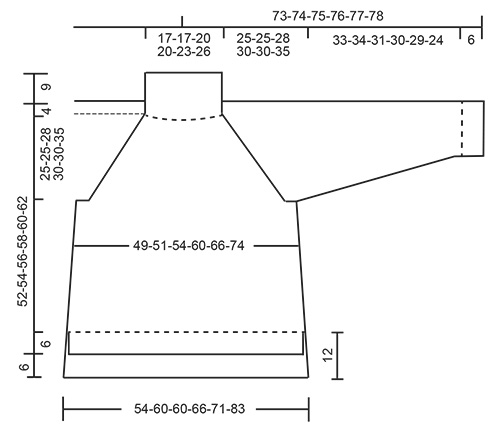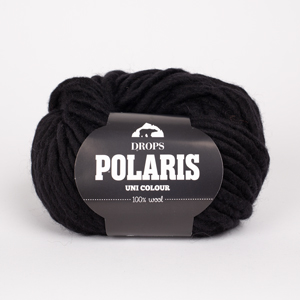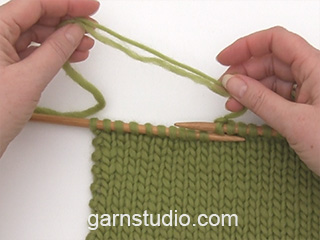Elise |
|
 |
 |
Knitted jumper with raglan, high collar and split in the sides, worked top down. Sizes S - XXXL. The piece is worked in 1 strand DROPS Polaris or 4 strands Air.
DROPS 184-8 |
|
|
INFORMATION FOR THE PATTERN: CHANGING THE STRAND-TIP (applies if using Polaris): When changing balls with Polaris divide the old strand in two for the last 15 cm / 6" – cut off one of the parts, and do the same with the new strand. Lay the first and the last 15 cm / 6" over each other so that you get the normal thickness of the yarn and continue working – in this way you do not get a visible join in the yarn. DECREASE TIP-1: Start 2 stitches before the marker thread, knit 2 stitches together, (the marker thread sits here), slip 1 stitch as if to knit, knit 1, pass the slipped stitch over. DECREASE TIP-2: NOTE: So that the decreases are made alternately in the right and left side of the piece, decrease as follows: In sizes S, M and L decrease alternately at the beginning and end of the rows you are decreasing on. In sizes XL, XXL and XXXL decrease at the beginning of row you are decreasing on (alternately from right side and from wrong side of piece). Decrease as follows from the right side: Knit 2 stitches together. Decrease as follows from the wrong side: Purl 2 stitches together. MAGIC LOOP: If you are working in the round with a circular needle which is too long for the number of stitches, you can do as follows: The circular needle should be long and have a flexible wire. Push the stitches to the middle of the wire. Divide the stitches in the middle and pull the wire out between the stitches. Push the stitches to the ends of the needle in each side; make sure the stitches are not twisted. The yarn strand you are working with is on the back needle and you begin working on the front needle. Pull out the back needle to work the stitches on the front needle. When the stitches on the front needle have been worked, turn and push the stitches back on the empty needle and work the other side in the same way. Continue like this in the round, making sure you always pull out the needle on the side you have the strand on. RAGLAN: Increase to raglan on each side of the marker thread (= 8 stitches increased on the round). Increase as follows, start 1 stitch before the marker thread: Make 1 yarn over, knit 2 stitches (the marker thread sits in the middle of these stitches), make 1 yarn over. On the next round knit the yarn overs twisted to prevent holes. INCREASE TIP (for body): Increase 1 stitch by making a yarn over. On the next round knit the yarn overs twisted to prevent holes. RIDGE/GARTER STITCH (worked back and forth): 1 ridge = Knit 2 rows. ---------------------------------------------------------- JUMPER: The piece is worked in the round with circular needle and top down. The sleeves are worked back and forth with circular needle. Read CHANGING THE STRAND-TIP (applies if using Polaris)! YOKE: Cast on 40-40-44-44-48-52 stitches with circular needle size 15 mm / US 19 and 1 strand Polaris or 4 strands Air. Work rib (knit 2/ purl 2) for 9 cm / 3½". Insert 4 marker threads in the piece without working the stitches as follows: First marker thread at the beginning of the round, second marker thread after 14-14-16-16-18-20 stitches (= back piece), third marker thread after 6 new stitches (= sleeve), fourth marker thread after 14-14-16-16-18-20 new stitches (= front piece), there are now 6 stitches left before the first marker thread (= sleeve). Knit 1 round where you decrease 1 stitch on each side of each marker thread – read DECREASE TIP-1 = 32-32-36-36-40-44 stitches. NOTE: In our assortment we do not have shorter circular needles than 60 cm / 23½" in needle size 15 mm / US 19. You have now decreased stitches so that the circumference of the piece is smaller than 60 cm / 23½" in sizes S - XXL. Therefore, continue working with MAGIC LOOP – see description above until you have increased enough stitches to use circular needle 60 cm / 23½" or 80 cm / 32" as normal. Work stockinette stitch, AT THE SAME TIME on round 2 start increases to RAGLAN – see description above. Increase in this way every 2nd round 8-10-10-11-12-14 times = 96-112-116-124-136-156 stitches. REMEMBER THE GAUGE! The increases to raglan are now finished in sizes M, L, XXL and XXXL. In sizes S and XL work 1 more round where you increase 1 stitch on the front and back pieces in the same way (do not increase on the sleeves) = 4 stitches increased. There are now 100-112-116-128-136-156 stitches on the round. The piece measures approx. 21-25-25-29-30-35 cm / 8¼"-9¾"-9¾"-11½"-11¾"-13¾" from after the rib and down. Continue without increases for 3-0-2-1-0-0 more rounds. The piece measures approx. 25-25-28-30-30-35 cm / 9¾"-9¾"-11"-11¾"-11¾"-13¾" from after the rib and down. The next round is worked as follows: Work 30-32-34-38-40-46 stitches (= back piece), place the next 20-24-24-26-28-32 stitches on a thread (= sleeve), cast on 4-4-4-4-6-6 stitches under the sleeve, work 30-32-34-38-40-46 stitches (= front piece), place the next 20-24-24-26-28-32 stitches on a thread (= sleeve), cast on 4-4-4-4-6-6 stitches under the sleeve. Insert a marker in the piece. THE PIECE IS NOW MEASURED FROM HERE! BODY: = 68-72-76-84-92-104 stitches. Continue with stockinette stitch. Insert 1 marker thread in each side in the middle of the new stitches which were cast on (= 2-2-2-2-3-3 new stitches on each side of the marker thread) and 34-36-38-42-46-52 stitches between marker threads for the back and front pieces. Now increase in the sides as follows – read INCREASE TIP: When the piece measures 5 cm / 2" increase 1 stitch before each marker thread. When the piece measures 8 cm / 3⅛" increase 1 stitch after each marker thread. When the piece measures 10 cm / 4" increase 1 stitch before each marker thread. When the piece measures 12 cm / 4¾" increase 1 stitch after each marker thread. There are now 76-80-84-92-100-112 stitches on the round. Now continue as follows in the different sizes: Sizes S, L, XL and XXL: Continue in the round with stockinette stitch until the piece measures 17-18-18-20 cm / 6¾"-7"-7"-8". Sizes M and XXXL: Continue in the round with stockinette stitch until the piece measures19-17 cm / 7½"-6¾" and at the same time increase as follows: When the piece measures 14 cm / 5½" increase 1 stitch before each marker thread. When the piece measures 16 cm / 6¼" increase 1 stitch after each marker thread. ALL SIZES: There are now 76-84-84-92-100-116 stitches on the round. When the piece measures 17-19-18-18-20-17 cm / 6¾"-7½"-7"-7"-8"-6¾" place the 38-42-42-46-50-58 stitches on the back piece on a thread. Continue by working rib back and forth over the 38-42-42-46-50-58 stitches on the front piece. Start from the right side and work as follows: 2 stitches GARTER STITCH - see description above, * knit 2, purl 2 *, work from *-* until there are 4 stitches left on the needle, knit 2 and finish with 2 stitches garter stitch. Continue in this way until the rib measures 6 cm / 2⅜" and the piece a total of 52-54-56-58-60-62 cm / 20½"-21¼"-22"-22¾"-23⅝"-24⅜" from the shoulder down. Loosely bind off with knit over knit and purl over purl. Place the stitches from the back piece back on the needle and work stockinette stitch with 2 edge stitches in garter stitch in each side for 6 cm / 2⅜". Then work rib back and forth in the same way as for the front piece until the rib measures 6 cm / 2⅜". The split on the front piece is 6 cm / 2⅜" long; the split on the back piece is 12 cm / 4¾" long. The piece measures in total approx. 58-60-62-64-66-68 cm / 22¾"-23⅝"-24⅜"-25¼"-26"-26¾" from the shoulder and down the back piece. SLEEVE: The sleeves are worked back and forth with circular needle and are sewn together at the end. Place the 20-24-24-26-28-32 stitches from the thread back on circular needle size 15 mm / US 19 and cast on 2-2-2-2-3-3 new stitches in each side = 24-28-28-30-34-38 stitches. Work stockinette stitch back and forth over all stitches. When the piece measures 4-4-2-4-4-2 cm / 1½"-1½"-¾"-1½"-1½"-¾" decrease 1 stitch in the right side of the piece – read DECREASE TIP-2. Decrease alternately in the left and right side of the piece every 2nd-2nd-2nd-1st-1st-1st row 8-12-12-14-14-18 times (= 4-6-6-7-7-9 times in each side) = 16-16-16-16-20-20 stitches. When the piece measures 33-34-32-30-29-24 cm / 13"-13½"-12½"-11¾"-11½"-9½" work rib (knit 2, purl 2) for 6 cm / 2⅜". Loosely bind off with knit over knit and purl over purl. Work the other sleeve in the same way. ASSEMBLY: Sew the seams under the sleeves in the outermost loop of the outermost stitch so that the seam is not thick. Sew the opening under the sleeves. |
|

|
|
|
Have you made this or any other of our designs? Tag your pictures in social media with #dropsdesign so we can see them! Do you need help with this pattern?You'll find tutorial videos, a Comments/Questions area and more by visiting the pattern on garnstudio.com. © 1982-2024 DROPS Design A/S. We reserve all rights. This document, including all its sub-sections, has copyrights. Read more about what you can do with our patterns at the bottom of each pattern on our site. |
|




























































Comments / Questions (12)
Hej Jeg forstår ikke helt hvilke materialer jeg skal bruge til denne sweater? Er det rundpind i 60 cm kun men hvad størrelse ? :)
30.12.2019 - 10:42DROPS Design answered:
Hei Josefine. Du skal bruke str. nr. 15. DROPS RUNDPINDE (60 og 80 cm) nr 15 – eller de pinde du skal bruge for at få 7 masker og 8 pinde glatstrik på 10 cm i bredden og 10 cm i højden med 1 tråd Polaris eller 4 tråde Air. God Fornøyelse!
20.01.2020 - 11:35Erittäin hyvät ohjeet jopa minä onnistuin saamaan hyvän tuloksen Kaunis pusero
17.12.2019 - 17:51È giusto diminuire maglie dopo il collo se si usa lo stesso ferro quindi non di misura inferiore per il collo come di solito consigliate alla fine delle coste collo diminuire maglie quando si passa a ferro misura maggiore?
22.08.2019 - 20:35DROPS Design answered:
Buonasera Claudia, non ci sono errori nelle spiegazioni: le maglie vengono comunque diminuite perchè la lavorazione a coste tende a "tirare" il lavoro, che risulterebbe troppo molle se non si diminuissero le maglie. Buon lavoro!
22.08.2019 - 21:27Hvor mange nøster trengs til Str M?
26.03.2019 - 10:46DROPS Design answered:
Hei Olga, For størrelse M trenger du 1300 g DROPS Polaris eller 650 g DROPS Air. Hver nøste er 50 g, så det blir 26 nøster Polaris eller 13 nøster Air. God fornøyelse!
27.03.2019 - 06:54Egner dette mønsteret seg for nybegynnere?
02.12.2018 - 10:44Bonjour! Pourquoi faire des diminutions après le col pour augmenter exactement le même nombre de mailles le tour suivant? Est-ce pour ajuster le col et resserrer un peu le travail après les côtes 2/2? Un commentaire précédent en anglais (que je parle parfaitement) évoque ce réajustement, mais je n'en saisis pas bien l\'intérêt. Merci de m'éclairer.
30.10.2018 - 12:41DROPS Design answered:
Bonjour Éloïse, on diminue à la fin du col pour ajuster à la bonne taille (circonférence), puis on augmente pour le raglan, de chaque côté de chacun des 4 marqueurs. Bon tricot!
30.10.2018 - 14:39Bonjour! \r\nPourquoi faire des diminutions après le col pour augmenter exactement le même nombre de mailles le tour suivant? Est-ce pour ajuster le col et resserrer un peu le travail après les côtes 2/2? Un commentaire précédent en anglais (que je parle parfaitement) évoque ce réajustement, mais je n\'en saisis pas bien l\'intérêt. Merci de m\'éclairer.
30.10.2018 - 12:39Hei. Kan dere hjelpe meg å finne et mønster på en enkel damegenser, må bruke tykke pinner, raglanfelling, starte nede, ikke hårete garn.... Åshild
05.09.2018 - 14:00DROPS Design answered:
Hej Åshild, hvad med denne DROPS 164-12 med eller uden fletter i DROPS Eskimo eller 2 tråde fra garngruppe C DROPS Garngrupper God fornøjelse! :)
11.09.2018 - 09:35What do decrease in the yoke do? In particular the instruction says to decrease 1 stitch on each side of each marker thread. Can I omit this step?
25.04.2018 - 08:03DROPS Design answered:
Dear Amy, these dec will get the measurements getting right, you first dec after ribbing (ribbing will tighten piece more than stocking will) then start to increase for raglan. Happy knitting!
25.04.2018 - 08:45Could you give me some tips on how I could turn it into a turtleneck? 40 stitches would be a bit too much
23.04.2018 - 10:54DROPS Design answered:
Dear Amy, most of the time a turtleneck is worked over the same number of sts as a crew neck but just over more rows. For any assistance adjusting the pattern to your own taste please feel free to contact the store where you bought your yarn, even per mail telephone or social media. Happy knitting!
23.04.2018 - 11:23